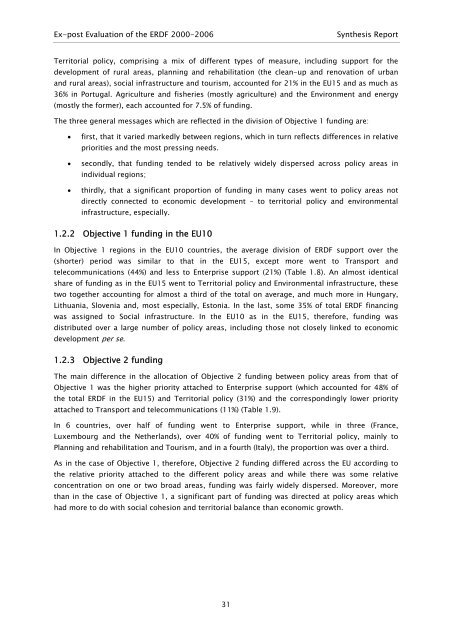Synthesis Report - European Commission - Europa
Synthesis Report - European Commission - Europa
Synthesis Report - European Commission - Europa
You also want an ePaper? Increase the reach of your titles
YUMPU automatically turns print PDFs into web optimized ePapers that Google loves.
Ex-post Evaluation of the ERDF 2000-2006<br />
<strong>Synthesis</strong> <strong>Report</strong><br />
Territorial policy, comprising a mix of different types of measure, including support for the<br />
development of rural areas, planning and rehabilitation (the clean-up and renovation of urban<br />
and rural areas), social infrastructure and tourism, accounted for 21% in the EU15 and as much as<br />
36% in Portugal. Agriculture and fisheries (mostly agriculture) and the Environment and energy<br />
(mostly the former), each accounted for 7.5% of funding.<br />
The three general messages which are reflected in the division of Objective 1 funding are:<br />
• first, that it varied markedly between regions, which in turn reflects differences in relative<br />
priorities and the most pressing needs.<br />
• secondly, that funding tended to be relatively widely dispersed across policy areas in<br />
individual regions;<br />
• thirdly, that a significant proportion of funding in many cases went to policy areas not<br />
directly connected to economic development – to territorial policy and environmental<br />
infrastructure, especially.<br />
1.2.2 Objective 1 funding in the EU10<br />
In Objective 1 regions in the EU10 countries, the average division of ERDF support over the<br />
(shorter) period was similar to that in the EU15, except more went to Transport and<br />
telecommunications (44%) and less to Enterprise support (21%) (Table 1.8). An almost identical<br />
share of funding as in the EU15 went to Territorial policy and Environmental infrastructure, these<br />
two together accounting for almost a third of the total on average, and much more in Hungary,<br />
Lithuania, Slovenia and, most especially, Estonia. In the last, some 35% of total ERDF financing<br />
was assigned to Social infrastructure. In the EU10 as in the EU15, therefore, funding was<br />
distributed over a large number of policy areas, including those not closely linked to economic<br />
development per se.<br />
1.2.3 Objective 2 funding<br />
The main difference in the allocation of Objective 2 funding between policy areas from that of<br />
Objective 1 was the higher priority attached to Enterprise support (which accounted for 48% of<br />
the total ERDF in the EU15) and Territorial policy (31%) and the correspondingly lower priority<br />
attached to Transport and telecommunications (11%) (Table 1.9).<br />
In 6 countries, over half of funding went to Enterprise support, while in three (France,<br />
Luxembourg and the Netherlands), over 40% of funding went to Territorial policy, mainly to<br />
Planning and rehabilitation and Tourism, and in a fourth (Italy), the proportion was over a third.<br />
As in the case of Objective 1, therefore, Objective 2 funding differed across the EU according to<br />
the relative priority attached to the different policy areas and while there was some relative<br />
concentration on one or two broad areas, funding was fairly widely dispersed. Moreover, more<br />
than in the case of Objective 1, a significant part of funding was directed at policy areas which<br />
had more to do with social cohesion and territorial balance than economic growth.<br />
31

















